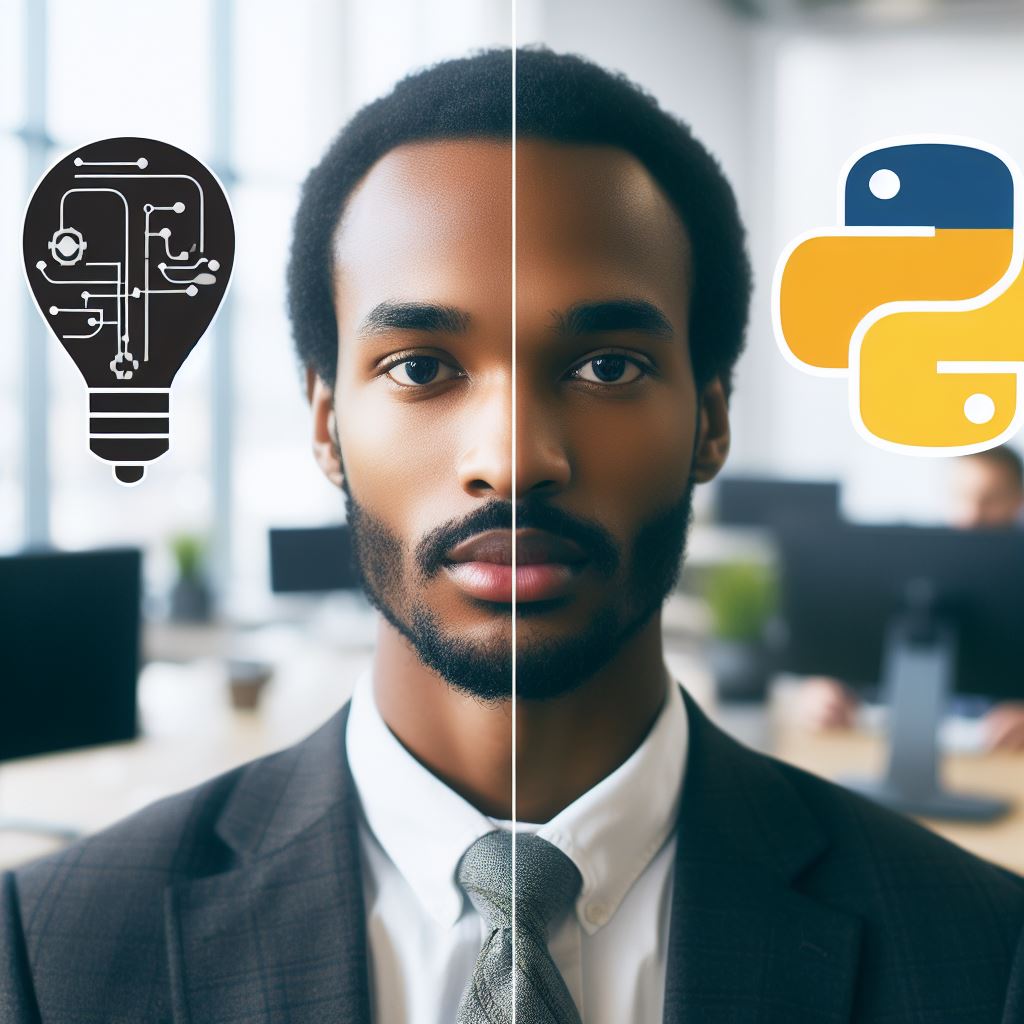Introduction
Choosing the right programming language is crucial in today’s rapidly evolving tech landscape. It can determine the success or failure of a project.
In this post, we will explore the comparison between two popular languages: PHP and Python.
Importance of Choosing the Right Programming Language
Selecting the appropriate programming language is vital as it affects the development process, performance, scalability, and maintenance.
It can save time, effort, and resources in the long run.
Brief Overview of PHP and Python
PHP is a server-side scripting language widely used for web development. It offers simplicity and extensive documentation, making it ideal for beginners. It seamlessly integrates with HTML code.
Python, on the other hand, is a versatile language known for its readability and clean syntax. It excels in data analysis, artificial intelligence, and scientific computing.
Python’s extensive libraries augment its capabilities.
Both languages have distinct advantages. PHP is known for its wide use in content management systems and e-commerce websites.
It provides excellent support for database integration. Python, on the other hand, is applauded for its versatility and simplicity.
Choosing between PHP and Python depends on the specific needs and requirements of a project.
PHP suits web development and content management, while Python excels in data analysis and scientific computing. Understanding the strengths of each language is crucial in making an informed decision.
Background of PHP
History and Origin
PHP (Hypertext Preprocessor) was created by Rasmus Lerdorf in 1994 as a set of CGI binaries written in C.
It originally stood for “Personal Home Page,” but later it was renamed to “PHP: Hypertext Preprocessor.”
Features and Advantages
- PHP is a server-side scripting language used for web development that can generate dynamic content.
- It is freely available and open-source, which makes it highly accessible and cost-effective.
- PHP is easy to learn and has a large community of developers, providing extensive support and resources.
- It offers seamless integration with popular databases like MySQL, PostgreSQL, and Oracle.
- PHP has excellent compatibility with different operating systems, including Windows, Linux, and macOS.
- It provides built-in security features, such as input validation and encryption functions, to protect against web vulnerabilities.
Common Use Cases
- PHP is mainly used for creating dynamic websites, web applications, and e-commerce platforms.
- It powers numerous content management systems (CMS) like WordPress and Drupal.
- It is widely used to handle form data, process user inputs, and interact with databases.
- PHP can be utilized to develop REST APIs, enabling data exchange between different platforms.
- It facilitates the creation of user authentication systems and secure login mechanisms.
- PHP is often used for server-side web development tasks such as file management and data manipulation.
In fact, PHP is a powerful server-side scripting language with a rich history and extensive features.
Its simplicity, vast community, and compatibility with various databases and operating systems make it a popular choice for web development.
Tech Consulting Tailored to Your Coding Journey
Get expert guidance in coding with a personalized consultation. Receive unique, actionable insights delivered in 1-3 business days.
Get StartedFrom dynamic websites to e-commerce platforms, PHP has proven to be a reliable tool for various use cases.
Read: Girls Who Code: Breaking Barriers in USA’s Tech World
Background of Python
History and origin
Python is a versatile programming language with a rich history and a wide range of applications.
It was created in the late 1980s by Guido van Rossum, a Dutch programmer, with the intention of making a language that would be easy to read and write.
Python is known for its simplicity and readability, which has contributed to its popularity among developers of all skill levels.
Features and advantages
One of the key advantages of Python is its extensive set of libraries and frameworks.
These libraries provide pre-written code that allows developers to quickly and efficiently complete tasks without having to start from scratch.
This saves time and reduces the likelihood of errors in the code. Some popular Python libraries include NumPy, Pandas, and Matplotlib, which are commonly used in data analysis and visualization.
Common use cases
Python’s versatility is also evident in its wide range of applications. It is commonly used for web development, scientific computing, data analysis, machine learning, and artificial intelligence.
The simplicity and readability of Python make it a great choice for beginners who are just starting to learn programming. Its syntax is clear and concise, making it easier to understand and debug code.
Python’s use cases extend beyond software development. It is frequently used for automating repetitive tasks, such as web scraping, file handling, and data manipulation.
Its simplicity and versatility make it an ideal language for scripting and automation.
Another advantage of Python is its strong community support. There are numerous online resources, forums, and tutorials available to help developers learn and solve problems.
The Python community is active and vibrant, with regular updates and improvements being made to the language and its libraries.
Build Your Vision, Perfectly Tailored
Get a custom-built website or application that matches your vision and needs. Stand out from the crowd with a solution designed just for you—professional, scalable, and seamless.
Get StartedPython’s popularity and wide range of applications have led to its adoption by major companies and organizations.
Google, Instagram, Dropbox, and Reddit are just a few examples of companies that use Python in their development process.
Its simplicity, readability, and efficient libraries make Python a favorite among developers in various industries.
In short, Python is a versatile programming language with a rich history and numerous advantages.
Its simplicity, readability, extensive libraries, and strong community support have contributed to its popularity and widespread use.
Whether you are a beginner or an experienced developer, Python is a language worth considering for your next project.
Read: How to Build a Simple Blog Using PHP and MySQL
Comparison of Syntax
Syntax examples and differences between PHP and Python
- PHP uses dollar sign ($) before the variable name, while Python doesn’t require any special character.
- PHP uses semicolons (;) at the end of each statement, while Python uses line breaks.
- PHP uses curly braces ({}) to define blocks of code, while Python uses indentation.
- PHP has a more flexible syntax with multiple ways to accomplish the same task, while Python follows a clear and strict syntax.
- PHP has a shorter syntax for loops and conditions compared to Python.
Ease of readability and writing
Python is often considered easier to read and write due to its clean and straightforward syntax:
- Python code is highly readable with its consistent indentation and lack of special characters.
- Python focuses on simplicity, making it easier for beginners to understand and write code.
- PHP syntax can be more complex and harder to read, especially for those new to programming.
- PHP’s flexibility can lead to code that is difficult to understand and maintain.
Preferences based on personal coding style
The choice between PHP and Python syntax often comes down to personal coding style:
- Some developers prefer PHP’s flexibility and familiarity, especially if they have a background in C or JavaScript.
- Others prefer Python’s strict syntax and readability, as it enforces good coding practices.
- Python’s syntax is often considered more elegant and aesthetically pleasing.
- Python’s readability makes it easier for multiple developers to collaborate on a project.
- PHP’s flexibility can be an advantage for more experienced developers who want greater control over their code.
In general, the syntax comparison between PHP and Python reveals distinct differences. PHP’s syntax offers more flexibility, while Python’s syntax focuses on readability and simplicity.
Python tends to be easier to read and write, especially for beginners, due to its clean syntax.
However, personal coding style and familiarity with a particular language play a significant role in choosing between PHP and Python.
Performance and Speed
In the world of programming, there is a constant debate over which language is better: PHP or Python. Both have their strengths and weaknesses, but one of the key factors to consider is performance and speed.
Comparison of performance benchmarks between PHP and Python
- PHP is known for its fast processing speed and efficient execution.
- Python, on the other hand, is generally slower compared to PHP.
- When it comes to benchmarks, PHP tends to outperform Python in most cases.
- PHP’s ability to handle large-scale web applications makes it a popular choice among developers.
- Python, although slower, is highly regarded for its simplicity and readability.
Factors affecting execution speed
- One of the main factors that affect execution speed is the design and architecture of the code.
- Optimizing algorithms and using efficient data structures can significantly improve the speed of both PHP and Python.
- Hardware and server configurations also play a role in the execution speed of a program.
- PHP has the advantage of being able to run as a server-side scripting language, enhancing its performance.
Importance of performance based on project requirements
- For projects that require real-time processing and instant response, PHP is a better choice.
- If the project involves complex scientific calculations or data analysis, Python’s simplicity and flexibility may outweigh its slower speed.
- Consider the specific needs and requirements of the project before making a decision.
- It is crucial to prioritize performance based on the project’s goals and user expectations.
- Choosing the right language will ensure the optimal user experience and efficient functioning of the application.
In review, performance and speed are important factors to consider when choosing between PHP and Python.
Optimize Your Profile, Get Noticed
Make your resume and LinkedIn stand out to employers with a profile that highlights your technical skills and project experience. Elevate your career with a polished and professional presence.
Get NoticedPHP generally outperforms Python in terms of execution speed, making it suitable for large-scale web applications.
However, Python’s simplicity and flexibility can outweigh its slower speed for certain projects.
Understanding the specific requirements of the project is crucial in making the right decision. Ultimately, the goal is to deliver an application that meets the needs of users while ensuring efficient performance.
Read: Mastering PHP Arrays: Tips, Tricks, and Techniques

Ecosystem and Community Support
When choosing a programming language, it is important to consider the ecosystem and community support that surrounds it.
This support plays a crucial role in a developer’s ability to learn, grow, and solve problems efficiently. In this section, we will compare the ecosystem and community support for PHP and Python.
Availability of libraries and frameworks in PHP and Python
Both PHP and Python have a wide range of libraries and frameworks available, making it easier for developers to build applications.
- PHP has a vast number of libraries and frameworks such as Laravel, Symfony, and CodeIgniter.
- Python also offers a rich collection of libraries and frameworks including Django, Flask, and Pyramid.
These libraries and frameworks provide ready-to-use components, reducing the time and effort required to develop complex functionalities.
Community size and active participation
The size and activity of a programming language community can greatly impact a developer’s experience and access to resources.
PHP is a popular choice for web development, and it has a large and active community. This means that developers can count on getting help, finding resources, and engaging in discussions easily.
The PHP community is known for its eagerness to share knowledge and support beginners.
Python also boasts a thriving and enthusiastic community. It has gained popularity in recent years and attracts developers from various backgrounds.
The Python community actively contributes to the language’s development and provides valuable resources and support to fellow developers.
Access to learning resources and support
Learning resources and support are essential for developers, especially when starting with a new programming language.
PHP has a wide range of documentation, tutorials, and online courses available. The availability of resources ensures that developers can quickly get up to speed with the language and its various frameworks.
Additionally, forums and online communities provide ample support for troubleshooting issues and seeking guidance.
Python also offers an abundance of learning resources, including comprehensive documentation, video tutorials, and interactive coding platforms.
Python’s popularity has led to the creation of numerous beginner-friendly resources, making it easier for newcomers to learn and progress.
Both PHP and Python have impressive ecosystems and strong community support. The availability of libraries and frameworks empowers developers to build robust applications efficiently.
Moreover, the size and participation of their respective communities ensure access to abundant learning resources and support.
Ultimately, the choice between PHP and Python depends on the specific needs and preferences of the developer.
It is advisable to consider factors beyond community support, such as the nature of the project, performance requirements, and personal familiarity with the language.
Both PHP and Python offer powerful tools and resources, enabling developers to create exceptional applications.
Read: Closing the Tech Gap: Coding Programs for U.S. Seniors
Scalability and Flexibility
When it comes to choosing between PHP and Python, scalability and flexibility are important factors to consider. Both languages have their own strengths and weaknesses in this regard.
Scalability capabilities of PHP and Python
1. PHP
- PHP is known for its ability to handle high traffic websites with ease.
- It has a built-in caching mechanism and supports various caching technologies, making it highly scalable.
- PHP’s extensive libraries and frameworks allow developers to easily scale up their projects.
2. Python
- Python is also highly scalable and widely used in large-scale projects.
- It has a robust ecosystem and supports horizontal scaling, making it suitable for handling heavy workloads.
- Python’s simplicity and readability make it an excellent choice for scaling complex systems.
Ability to handle large projects and future growth
1. PHP
- PHP is widely used in the development of large-scale projects, including enterprise-level applications.
- Its mature frameworks like Laravel and Symfony provide structure and organization for handling complex projects.
- PHP’s scalability and extensive community support make it a reliable choice for future growth.
2. Python
- Python’s simplicity and easy learning curve make it suitable for both small and large projects.
- It supports modular programming, allowing developers to break down large projects into manageable components.
- Python’s versatility and extensive libraries like Django and Flask make it a powerful choice for building large-scale applications.
Flexibility in integrating with other technologies
1. PHP
- PHP has excellent integration capabilities, making it easy to work with other technologies like databases and CMS platforms.
- It has built-in support for popular databases like MySQL, PostgreSQL, and Oracle.
- PHP can be seamlessly integrated with content management systems like WordPress and Drupal.
2. Python
- Python’s versatility extends to its ability to integrate with various technologies and platforms.
- It has robust support for interacting with databases, web services, and APIs.
- Python’s wide adoption in the scientific and data analysis community makes it a popular choice for integration with analytics tools and frameworks.
In a nutshell, both PHP and Python have their own strengths when it comes to scalability, handling large projects, and flexibility in integrating with other technologies.
Choosing between the two ultimately depends on the specific requirements of your project and your familiarity with each language.
Web Development
When it comes to web development, both PHP and Python offer a range of frameworks that can be used to build powerful and dynamic websites.
Let’s take a closer look at PHP and Python frameworks for web development, along with a comparison of their features, ease of use, and popularity.
PHP Frameworks for Web Development
- Laravel: Laravel is one of the most popular PHP frameworks known for its elegant syntax and vast community support. It provides a clean and expressive way to develop web applications.
- Symfony: Symfony is a highly flexible PHP framework that follows the MVC (Model-View-Controller) pattern. It offers a wide range of components and tools that simplify the development process.
Python Frameworks for Web Development
- Django: Django is a high-level Python web framework that promotes rapid development, clean design, and reusability of code. It provides a robust set of tools for building scalable web applications.
- Flask: Flask is a lightweight Python framework that is perfect for small to medium-sized projects. It offers simplicity and flexibility, allowing developers to create web applications with ease.
Comparison of Features, Ease of Use, and Popularity
When comparing PHP and Python frameworks, it’s essential to consider factors like features, ease of use, and popularity.
PHP frameworks like Laravel and Symfony have a significant advantage in terms of popularity.
They have a vast and active community that provides excellent support, documentation, and numerous pre-built libraries and plugins.
Python frameworks like Django and Flask also have their advantages. Django, for example, is known for its extensive set of built-in features, making it ideal for complex applications.
Flask, on the other hand, offers simplicity and flexibility, making it suitable for smaller projects and beginners.
In terms of ease of use, both PHP and Python frameworks have their learning curves. However, PHP frameworks are generally considered easier to learn and more beginner-friendly.
They have a straightforward syntax and clear documentation, making it relatively simple for developers to get started.
Python frameworks, on the other hand, require a bit more initial learning, especially for beginners.
However, once the basics are understood, Python provides a clean and readable syntax that is easy to maintain and understand in the long run.
Basically, choosing between PHP and Python for web development ultimately depends on your specific needs and preferences.
If you value popularity and community support, PHP frameworks like Laravel and Symfony are excellent choices.
If you prioritize extensive features and scalability, Python frameworks like Django are strong contenders. For smaller projects or beginners, Flask offers a lightweight and flexible option.
Remember, both PHP and Python have a strong presence in the web development world, and mastering either language will open doors to exciting opportunities.
So, take your time to explore and experiment with both options before making a decision!
Data Science and Machine Learning
Data science and machine learning have become increasingly important in various fields, driving the demand for programming languages that can effectively handle these tasks.
Python has emerged as a dominant language in this domain, while PHP has limited capabilities in data science and machine learning.
Python’s dominance in data science and machine learning
Python’s popularity in data science and machine learning can be attributed to its rich library ecosystem, particularly with libraries like NumPy, Pandas, and Scikit-learn.
These libraries provide powerful functionalities and tools for handling large datasets, performing complex statistical analysis, and building machine learning models.
PHP’s limited capabilities in this area
On the other hand, PHP, the popular language for web development, lacks the extensive libraries and frameworks necessary for data science and machine learning tasks.
PHP’s focus is primarily on web-based applications, making it less suitable for computationally intensive tasks and advanced statistical analysis.
Use cases and advantages of Python in data science
The advantages of Python in data science are evident through its wide range of applications and use cases.
Python is commonly used in areas such as predictive analytics, natural language processing, image recognition, and sentiment analysis.
Its simplicity and readability make it accessible to both beginners and experienced programmers in the data science field.
Python’s extensive library ecosystem offers specialized tools for different data science tasks.
NumPy, for example, is widely used for efficient numerical computations, while Pandas provides data structures and data analysis tools.
Scikit-learn offers a comprehensive set of machine learning algorithms and tools for model training and evaluation.
The flexibility of Python also allows seamless integration with other programming languages and tools, making it a preferred choice for data scientists and machine learning practitioners.
Python’s compatibility with R, a popular language for statistical computing, enables easy collaboration and sharing of code between data scientists using different languages.
In addition to its powerful libraries, Python benefits from a vibrant and supportive community.
The Python community actively contributes to the development of new libraries, shares knowledge and best practices through forums and online communities, and provides continuous updates and improvements to the language.
This strong community support fosters innovation and promotes the adoption of Python in data science and machine learning.
All in all, when it comes to data science and machine learning, Python stands out as the preferred language due to its extensive library ecosystem, flexibility, and strong community support.
PHP’s limited capabilities in this area make it less suitable for handling complex data analysis tasks.
Therefore, for individuals and organizations looking to excel in data science and machine learning, Python is undoubtedly the language of choice.
Gain More Insights: Mid-Career Shifts: Moving into Coding Jobs After 40
Conclusion
PHP and Python are both powerful programming languages, but they have some key differences and similarities.
Regarding syntax, PHP uses C-style syntax, while Python uses indentation and whitespace.
PHP is mainly used for web development, whereas Python has a broader range of applications, including web development, data analysis, and artificial intelligence.
When it comes to performance, PHP is generally faster and more efficient for web development, while Python’s performance varies depending on the task.
Python’s extensive libraries and frameworks make it a great choice for complex projects that require a lot of flexibility.
A major consideration for choosing the right language is community support. PHP has a large community and a vast collection of libraries and frameworks.
Python also has a strong community and offers numerous libraries and frameworks for various purposes.
Another factor to consider is the learning curve. PHP has a more straightforward and easier-to-learn syntax, making it a suitable choice for beginners.
Python, on the other hand, has a more intuitive and readable syntax, but it can be more challenging for beginners due to its extensive features.
The choice between PHP and Python should be based on your specific needs and goals. If you prioritize web development and simplicity, PHP may be the right choice for you.
If you require a versatile language with a wide range of applications, Python might be the better option.
To make an informed decision, consider factors such as the project requirements, performance needs, community support, and your personal preferences.
Ultimately, choose the language that aligns with your goals and allows you to develop efficiently and effectively.




